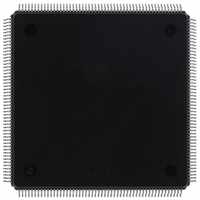MCF5407AI220 Freescale Semiconductor, MCF5407AI220 Datasheet - Page 457

MCF5407AI220
Manufacturer Part Number
MCF5407AI220
Description
IC MPU 32B 220MHZ COLDF 208-FQFP
Manufacturer
Freescale Semiconductor
Series
MCF540xr
Specifications of MCF5407AI220
Core Processor
Coldfire V4
Core Size
32-Bit
Speed
220MHz
Connectivity
EBI/EMI, I²C, UART/USART
Peripherals
DMA, WDT
Number Of I /o
16
Program Memory Type
ROMless
Ram Size
4K x 8
Voltage - Supply (vcc/vdd)
1.65 V ~ 3.6 V
Oscillator Type
External
Operating Temperature
0°C ~ 70°C
Package / Case
208-FQFP
Maximum Clock Frequency
220 MHz
Operating Supply Voltage
1.8 V, 3.3 V
Maximum Operating Temperature
+ 105 C
Mounting Style
SMD/SMT
Minimum Operating Temperature
0 C
Program Memory Size
24KB
Cpu Speed
220MHz
Embedded Interface Type
I2C, UART
Digital Ic Case Style
FQFP
No. Of Pins
208
Supply Voltage Range
3.3V
Rohs Compliant
Yes
For Use With
M5407C3 - KIT EVAL FOR MCF5407 W/ETHERNET
Lead Free Status / RoHS Status
Lead free / RoHS Compliant
Eeprom Size
-
Program Memory Size
-
Data Converters
-
Lead Free Status / Rohs Status
Lead free / RoHS Compliant
Available stocks
Company
Part Number
Manufacturer
Quantity
Price
Company:
Part Number:
MCF5407AI220
Manufacturer:
freescaie
Quantity:
6
Company:
Part Number:
MCF5407AI220
Manufacturer:
Freescale Semiconductor
Quantity:
135
Company:
Part Number:
MCF5407AI220
Manufacturer:
FREESCALE
Quantity:
1 831
Company:
Part Number:
MCF5407AI220
Manufacturer:
Freescale Semiconductor
Quantity:
10 000
- Current page: 457 of 546
- Download datasheet (7Mb)
1
2
3
4
18.9.2 Multiple External Bus Device Arbitration Protocol
Three-wire mode lets the MCF5407 share the external bus with multiple external devices.
This mode requires an external arbiter to assign priorities to each potential master and to
determine which device accesses the external bus. The arbiter uses the MCF5407 bus
arbitration signals, BR, BD, and BG, to control use of the external bus by the MCF5407.
The MCF5407 requests the bus from the external bus arbiter by asserting BR when the core
requests an access. It continues to assert BR until after the transfer starts. It can negate BR
at any time regardless of the BG status. If the MCF5407 is granted the bus when an internal
bus request is generated, it asserts BD and the access begins immediately. The MCF5407
always drives BR and BD, which cannot be directly wire-ORed with other devices.
The external arbiter asserts BG to grant the bus to MCF5407, which can begin a bus cycle
after the next rising edge of CLKIN. If BG is negated during a bus cycle, the MCF5407
releases the bus when the cycle completes. To guarantee that the bus is released, BG must
be negated before the rising edge of the CLKIN in which the last TA is asserted. Note that
the MCF5407 treats any series of burst or a burst-inhibited transfers as a single bus cycle
and does not release the bus until the last transfer of the series completes.
When the MCF5407 is granted the bus after it asserts BR, one of two things can occur. If
the MCF5407 has an internal bus request pending, it asserts BD, indicating explicit bus
mastership, and begins the pending bus cycle by asserting TS. The MCF5407 continues to
assert BD until the external bus arbiter negates BG, after which BD is negated at the
completion of the bus cycle. As long as BG is asserted, BD remains asserted to indicate that
the MCF5407 is bus master, and the MCF5407 continuously drives the address bus,
attributes, and control signals.
If no internal request is pending, the MCF5407 takes implicit bus mastership. It does not
drive the bus and does not assert BD if the bus has an implicit master. If an internal bus
request is generated, the MCF5407 assumes explicit bus mastership and immediately
begins an access and asserts BD. Figure 18-30 shows implicit and explicit bus mastership
due to generation of an internal bus request.
Both normal terminations and terminations due to bus errors generate an end of cycle. Bus cycles resulting from
a burst-inhibited transfer are considered part of that original transfer.
A means asserted.
N means negated.
EM means external master.
(Three-Wire Mode)
Chapter 18. Bus Operation
General Operation of External Master Transfers
18-29
Related parts for MCF5407AI220
Image
Part Number
Description
Manufacturer
Datasheet
Request
R
Part Number:
Description:
Mcf5407 Coldfire Integrated Microprocessor User
Manufacturer:
Freescale Semiconductor, Inc
Datasheet:
Part Number:
Description:
Manufacturer:
Freescale Semiconductor, Inc
Datasheet:
Part Number:
Description:
Manufacturer:
Freescale Semiconductor, Inc
Datasheet:
Part Number:
Description:
Manufacturer:
Freescale Semiconductor, Inc
Datasheet:
Part Number:
Description:
Manufacturer:
Freescale Semiconductor, Inc
Datasheet:
Part Number:
Description:
Manufacturer:
Freescale Semiconductor, Inc
Datasheet:
Part Number:
Description:
Manufacturer:
Freescale Semiconductor, Inc
Datasheet:
Part Number:
Description:
Manufacturer:
Freescale Semiconductor, Inc
Datasheet:
Part Number:
Description:
Manufacturer:
Freescale Semiconductor, Inc
Datasheet:
Part Number:
Description:
Manufacturer:
Freescale Semiconductor, Inc
Datasheet:
Part Number:
Description:
Manufacturer:
Freescale Semiconductor, Inc
Datasheet:
Part Number:
Description:
Manufacturer:
Freescale Semiconductor, Inc
Datasheet:
Part Number:
Description:
Manufacturer:
Freescale Semiconductor, Inc
Datasheet:
Part Number:
Description:
Manufacturer:
Freescale Semiconductor, Inc
Datasheet:
Part Number:
Description:
Manufacturer:
Freescale Semiconductor, Inc
Datasheet:











